LA-ICP-MS Analysis of Clinopyroxenes in Basaltic Pyroclastic Rocks from the Xisha Islands, Northwestern South China Sea
Abstract
:1. Introduction
2. Geological Setting and Sample Description
3. Analytical Methods
4. Mineral Composition of Clinopyroxenes
4.1. Major Element Composition of Clinopyroxenes
4.2. Trace Element Composition of Clinopyroxenes
5. Discussion
5.1. The Relationship between Clinopyroxene and the Host Rock
5.2. The Nature of Parental Magma
5.3. Isomorphic Replacements in Clinopyroxenes
5.4. Tectonic Setting Discrimination
6. Conclusions
Supplementary Materials
Author Contributions
Funding
Acknowledgments
Conflicts of Interest
References
- Yan, P.; Deng, H.; Liu, H.L.; Zhang, Z.Y.; Jiang, Y.K. The temporal and spatial distribution of volcanism in the South China Sea region. J. Asian Earth Sci. 2006, 27, 647–659. [Google Scholar] [CrossRef]
- Yan, J.Y.; Li, X.P.; Yan, Q.S. Geochemical characteristics and geological implications of clinopyroxenes in Cenozoic basalts from the South China Sea. Geol. Rev. 2014, 60, 824–838, (In Chinese with English Abstract). [Google Scholar]
- Zhou, H.M.; Xiao, L.; Dong, Y.X.; Wang, C.Z.; Wang, F.Z.; Ni, P.Z. Geochemical and geochronological study of the Sanshui basin bimodal volcanic rock suite, China: Implications for basin dynamics in southeastern China. J. Asian Earth Sci. 2009, 34, 178–189. [Google Scholar] [CrossRef]
- Xu, Y.G.; Wei, J.X.; Qiu, H.N.; Zhang, H.H.; Huang, X.L. Opening and evolution of the South China Sea constrained by studies on volcanic rocks: Preliminary results and a research design. Sci. Bull. 2012, 57, 3150–3164. [Google Scholar] [CrossRef]
- Hui, G.G.; Li, S.Z.; Li, X.Y.; Guo, L.L.; Suo, Y.H.; Somerville, I.D.; Zhao, S.J.; Hu, M.Y.; Lan, H.Y.; Zhang, J. Temporal and spatial distribution of Cenozoic igneous rocks in the South China Sea and its adjacent regions: Implications for tectono-magmatic evolution. Geol. J. 2016, 51, 429–447. [Google Scholar] [CrossRef]
- Song, X.; Li, C.F.; Yao, Y.; Shi, H.S. Magmatism in the evolution of the South China Sea: Geophysical characterization. Mar. Geol. 2017, 394, 4–15. [Google Scholar] [CrossRef]
- Yan, Q.S.; Shi, X.F.; Wang, K.S.; Bu, W.R.; Xiao, L. Major element, trace element, and Sr, Nd and Pb iso-tope studies of Cenozoic basalts from the South China Sea. Sci. China Ser. D-Earth 2008, 51, 550–566. [Google Scholar] [CrossRef]
- Yang, S.Y.; Fang, N.Q. Geochemical variation of volcanic rocks from the South China Sea and neighboring land: Implication for magmatic process and mantle structure. Acta Oceanol. Sin. 2015, 34, 112–124. [Google Scholar] [CrossRef]
- Yan, Q.S.; Shi, X.F.; Metcalfe, I.; Liu, S.F.; Xu, T.Y.; Kornkanitnan, N.; Sirichaiseth, T.; Yuan, L.; Zhang, Y.; Zhang, H. Hainan mantle plume produced late Cenozoic basaltic rocks in Thailand, Southeast Asia. Sci. Rep. 2018, 8, 2640. [Google Scholar] [CrossRef]
- Yan, Q.S.; Straub, S.; Shi, X.F. Hafnium isotopic constraints on the origin of late Miocene to Pliocene seamount basalts from the South China Sea and its tectonic implications. J Asian Earth Sci. 2018. [Google Scholar] [CrossRef]
- Zou, H.; Fan, Q. U-Th isotopes in Hainan basalts: Implications for subasthenospheric origin of EM2 mantle end-member and the dynamics of melting beneath Hainan Island. Lithos 2010, 116, 145–152. [Google Scholar] [CrossRef]
- Li, X.H.; Li, J.B.; Yu, X.; Wang, C.S.; Jourdan, F. 40Ar/39Ar ages of seamount trachytes from the South China Sea and implications for the evolution of the northwestern sub-basin. Geosci. Front. 2015, 6, 571–577. [Google Scholar] [CrossRef]
- Liu, E.T.; Wang, H.; Uysal, I.T.; Zhao, J.X.; Wang, X.C.; Feng, Y.X.; Pan, S.Q. Paleogene igneous intrusion and its effect on thermal maturity of organic-rich mudstones in the Beibuwan Basin, South China Sea. Mar. Petrol. Geol. 2017, 86, 733–750. [Google Scholar] [CrossRef]
- An, A.; Choi, S.; Yu, Y.; Lee, D. Petrogenesis of Late Cenozoic basaltic rocks from southern Vietnam. Lithos 2017, 272–273, 192–204. [Google Scholar] [CrossRef]
- Zhang, G.L.; Luo, Q.; Zhao, J.; Jackson, M.G.; Guo, L.S.; Zhong, L.F. Geochemical nature of sub-ridge mantle and opening dynamics of the South China Sea. Earth Planet. Sc. Lett. 2018, 489, 145–155. [Google Scholar] [CrossRef]
- Yan, Q.S.; Shi, X.F.; Wang, K.S.; Bu, W.R. Mineral chemistry and its genetic significance of clinopyroxene in Cenozoic basalts from the South China Sea. Acta Petrol. Sin. 2007, 23, 2981–2989, (In Chinese with English Abstract). [Google Scholar]
- Yan, J.Y.; Li, X.P.; Zhao, L.Q.; Yan, Q.S. Geochemistry of kaersutites in Cenozoic alkali basalts from the South China Sea. Geol. Rev. 2015, 61, 1434–1446, (In Chinese with English Abstract). [Google Scholar]
- Zhang, Z.C.; Xiao, X.C.; Wang, J.; Luo, Z. Mineral Chemistry of the Pulu Cenozoic volcanic rocks in the west Kunlun mountains and its constraints on the magmatic processes. Acta Mineral. Sin. 2005, 25, 237–248, (In Chinese with English Abstract). [Google Scholar]
- Niu, X.L.; Chen, B.; Ma, X. Clinopyroxenes from the Fanshan pluton, Hebei. Acta Petrol. Sin. 2009, 25, 359–373, (In Chinese with English Abstract). [Google Scholar]
- Olin, P.H.; Wolff, J.A. Rare earth and high field strength element partitioning between iron-rich clinopyroxenes and felsic liquids. Contrib. Mineral. Petrol. 2010, 160, 761–775. [Google Scholar] [CrossRef] [Green Version]
- Guezal, J.; Baghdadi, M.E.; Barakat, A. The Jurassic–Cretaceous volcanism of the Atlas of Beni-Mellal (Central High Atlas, Morocco): Evidence from clinopyroxene composition. Arab. J. Geosci. 2015, 8, 977–986. [Google Scholar] [CrossRef]
- Wang, K.M.; Wang, Z.Q.; Zhang, Y.L.; Wang, G. Mineral chemistry characteristics and indication significance of clinopyroxene in mafic rock of Gaoqiao area, North Daba Mountains. Acta Petrol. Mineral. 2014, 33, 527–539, (In Chinese with English Abstract). [Google Scholar]
- Liao, R.Q.; Huang, P.; Hu, N.J. A complex magmatic system beneath the middle and northern Okinawa Trough: Evidence from pyroxene characteristics. Geol. J. 2017, 52, 1059–1068. [Google Scholar] [CrossRef]
- Shu, S.Y.; Yang, X.Y.; Liu, L.; Liu, W.; Cao, J.Y.; Gao, E.G. Dual Geochemical Characteristics for the Basic Intrusions in the Yangtze Block, South China: New Evidence for the Breakup of Rodinia. Minerals 2018, 8, 288. [Google Scholar] [CrossRef]
- Kushiro, I. Si-Al relation in clinopyroxenes from igneous rock. Am. J. Sci. 1960, 258, 548–554. [Google Scholar] [CrossRef]
- Verhoogen, J. Distribution of titanium between silicates and oxides in igneous rocks. Am. J. Sci. 1962, 260, 211–220. [Google Scholar] [CrossRef]
- Nisbet, E.G.; Pearce, J.A. Clinopyroxene composition in mafic lavas from different tectonic settings. Contrib. Mineral. Petrol. 1977, 63, 149–160. [Google Scholar] [CrossRef]
- Leterrier, J.; Maury, R.C.; Thonon, P.; Girard, D.; Marchal, M. Clinopyroxene composition as a method of identification of the magmatic affinities of paleovolcanic series. Earth Planet. Sci. Lett. 1982, 59, 139–154. [Google Scholar] [CrossRef]
- Seyler, M.; Bonatti, E. Na, AlIV, and AlVI, in clinopyroxenes of subcontinental and suboceanic ridge peridotites: A clue to different melting processes in the mantle? Earth Planet. Sci. Lett. 1994, 122, 281–289. [Google Scholar] [CrossRef]
- Aparicio, A. Relationship between clinopyroxene composition and the formation environment of volcanic host rocks. IUP J. Earth Sci. 2010, 4, 1–11. [Google Scholar]
- Niu, X.L.; Yang, J.S.; Fei, L.; Zhang, H.Y.; Yang, M.C. Origin of Baotoudong syenites in North China Craton: Petrological, mineralogical and geochemical evidence. Sci. China Earth Sci. 2016, 59, 95–110. [Google Scholar] [CrossRef]
- Kargin, A.V.; Sazonova, L.V.; Nosova, A.A.; Tretyachenko, V.V. Composition of garnet and clinopyroxene in peridotite xenoliths from the Grib kimberlite pipe, Arkhangelsk diamond province, Russia: Evidence for mantle metasomatism associated with kimberlite melts. Lithos 2016, 262, 442–455. [Google Scholar] [CrossRef]
- Kil, Y.; Shin, H.S.; Oh, H.Y.; Kim, J.S.; Choi, M.S.; Shin, H.J.; Park, C.S. In-situ trace element analysis of clinopyroxene on thin section by using LA-ICP-MS. Geosci. J. 2011, 15, 177–183. [Google Scholar] [CrossRef]
- Hart, S.R.; Dunn, T. Experimental cpx/melt partitioning of 24 trace elements. Contrib. Mineral. Petrol. 1993, 113, 1–8. [Google Scholar] [CrossRef]
- Gilman, T.; Feineman, M.; Fisher, D. The Chulitna terrane of south-central Alaska: A rifted volcanic arc caught between the Wrangellia composite terrane and the Mesozoic margin of North America. Geol. Soc. Am. Bull. 2009, 121, 979–991. [Google Scholar] [CrossRef]
- Huang, X.L.; Niu, Y.; Xu, Y.G.; Chen, L.L.; Yang, Q.J. Mineralogical and Geochemical Constraints on the Petrogenesis of Post-collisional Potassic and Ultrapotassic Rocks from Western Yunnan, SW China. J. Petrol. 2010, 51, 1617–1654. [Google Scholar] [CrossRef] [Green Version]
- Sun, J.; Liu, C.Z.; Wu, F.Y.; Yang, Y.H.; Chu, Z.Y. Metasomatic origin of clinopyroxene in Archean mantle xenoliths from Hebi, North China Craton: Trace-element and Sr-isotope constraints. Chem. Geol. 2012, 328, 123–136. [Google Scholar] [CrossRef]
- Rollinson, H.; Gravestock, G. The trace element geochemistry of clinopyroxenes from pyroxenites in the Lewisian of NW Scotland: Insights into light rare earth element mobility during granulite facies metamorphism. Contrib. Mineral. Petrol. 2012, 163, 319–335. [Google Scholar] [CrossRef]
- Zuo, P.; Liu, X.; Hao, J.; Wang, Y.S.; Zhao, R.; Ge, S.S. Chemical compositions of garnet and clinopyroxene and their genetic significances in Yemaquan skarn iron-copper-zinc deposit, Qimantagh, eastern Kunlun. J. Geochem. Explor. 2015, 158, 143–154. [Google Scholar] [CrossRef]
- Xue, S.C.; Qin, K.Z.; Tang, D.M.; Mao, Y.J.; Yao, Z.S. Compositional characteristics of pyroxenes from Permian maficultramafic complexes in Eastern Xinjiang, and their implications for petrogenesis and Ni-Cu mineralization. Acta Petrol. Sin. 2015, 31, 2175–2192, (In Chinese with English Abstract). [Google Scholar]
- Jankovics, M.É.; Taracsák, Z.; Dobosi, G.; Embey-Isztin, A.; Batki, A.; Harangi, S.; Hauzenbergere, C.A. Clinopyroxene with diverse origins in alkaline basalts from the western Pannonian Basin: Implications from trace element characteristics. Lithos 2016, 262, 120–134. [Google Scholar] [CrossRef]
- Batki, A.; Pál-Molnár, E.; Jankovics, M.É.; Kerr, A.C.; Kiss, B.; Markl, G.; Heincz, A.; Harangi, S. Insights into the evolution of an alkaline magmatic system: An in situ trace element study of clinopyroxenes from the Ditrău Alkaline Massif, Romania. Lithos 2018, 300–301, 51–71. [Google Scholar] [CrossRef]
- Qiu, J.X.; Liao, Q.A. Petrogenesis and cpx mineral chemistry of Cenozoic basalts from Zhejiang and Fujian of eastern China. Volcanol. Mineral. Resour. 1996, 17, 16–25, (In Chinese with English Abstract). [Google Scholar]
- Krátký, O.; Rapprich, V.; Racek, M.; Míková, J.; Magna, T. On the Chemical Composition and Possible Origin of Na-Cr-Rich Clinopyroxene in Silico carbonatites from Samalpatti, Tamil Nadu, South India. Minerals 2018, 8, 355. [Google Scholar] [CrossRef]
- Campbell, I.H.; Borley, G.D. The geochemistry of pyroxenes from the lower layered series of the Jimberlana intrusion, Western Australia. Contrib. Mineral. Petrol. 1974, 47, 281–297. [Google Scholar] [CrossRef]
- Vuorinen, J.H.; Hålenius, U.; Whitehouse, M.J.; Mansfeld, J.; Skelton, A.D.L. Compositional variations (major and trace elements) of clinopyroxene and Ti-andradite from pyroxenite, ijolite and nepheline syenite, Alnö Island, Sweden. Lithos 2005, 81, 55–77. [Google Scholar] [CrossRef]
- Yao, B.C.; Wan, L.; Wu, N.Y. Cenozoic plate tectonic activities in the Great South China Sea area. Geol. China 2004, 31, 113–122, (In Chinese with English Abstract). [Google Scholar]
- Yan, Q.S.; Castillo, P.; Shi, X.F.; Wang, L.L.; Liao, L.; Ren, J.B. Geochemistry and petrogenesis of volcanic rocks from Daimao Seamount (South China Sea) and their tectonic implications. Lithos 2015, 218–219, 117–126. [Google Scholar] [CrossRef]
- Taylor, B.; Hayers, D.E. The tectonic evolution of the South China Sea. In The Tectonic and Geological Evolution of the Southeast Asian Seas and Islands, Geophys. Monogr. Ser.; Hayers, D.E., Ed.; American Geophysical Union: Washington, DC, USA, 1980; Volume 23, pp. 89–104. [Google Scholar]
- Briais, A.; Patriat, P.; Tapponnier, P. Updated interpretation of magnetic anomalies and seafloor spreading stages in the South China Sea: Implications for the Tertiary tectonics of Southeast Asia. J. Geophys. Res. Solid Earth 1993, 98, 6299–6328. [Google Scholar] [CrossRef]
- Kido, Y.; Suyehiro, K.; Kinoshita, H. Rifting to spreading process along the northern continental margin of the South China Sea. Mar. Geophys. Res. 2001, 22, 1–15. [Google Scholar] [CrossRef]
- Li, C.F.; Xu, X.; Lin, J.; Sun, Z.; Zhu, J.; Yao, Y.J.; Zhao, X.X.; Liu, Q.S.; Kulhanek, D.K.; Wang, J.; et al. Ages and magnetic structures of the South China Sea constrained by deep tow magnetic surveys and IODP Expedition 349. Geochem. Geophys. Geosyst. 2014, 15, 4958–4983. [Google Scholar] [CrossRef] [Green Version]
- Li, C.F.; Li, J.B.; Ding, W.W.; Franke, D.; Yao, Y.J.; Shi, H.S.; Pang, X.; Cao, Y.; Lin, J.; Kulhanek, D.K.; et al. Seismic stratigraphy of the central South China Sea basin and implications for neotectonics. J. Geophys. Res. (Solid Earth) 2015, 120, 1377–1399. [Google Scholar] [CrossRef] [Green Version]
- Xie, A.Y.; Zhong, L.F.; Yan, F. Time and genesis of Cenozoic magmaticcs in the South China Sea and surrounding areas. Mar. Geol. Quat. Geol. 2017, 37, 108–118, (In Chinese with English Abstract). [Google Scholar]
- Yan, Q.S.; Shi, X.F.; Castillo, P. The late Mesozoic-Cenozoic tectonic evolution of the South China Sea: A petrologic perspective. J. Asian Earth Sci. 2014, 85, 178–201. [Google Scholar] [CrossRef]
- Wang, R.; Yu, K.F.; Jones, B.; Wang, Y.H.; Zhao, J.X.; Feng, Y.X.; Bian, L.Z.; Xu, S.D.; Fan, T.L.; Jiang, W.; et al. Evolution and development of Miocene “island dolostones” on Xisha Islands, South China Sea. Mar. Geol. 2018, 406, 142–158. [Google Scholar] [CrossRef]
- Zhang, Y.; Yu, K.Y.; Qian, H.D.; Fan, T.L.; Yue, Y.F.; Wang, R.; Jang, W.; Xu, S.D.; Wang, Y.H. The basement and volcanic activities of the Xisha Islands: Evidence from the kilometer-scale drilling in the northwestern South China Sea. Geol. J. 2019, in press. [Google Scholar]
- Liu, Y.S.; Hu, Z.C.; Gao, S.; Günther, D.; Xu, J.; Gao, C.G.; Chen, H.H. In situ analysis of major and trace elements of anhydrous minerals by LA-ICP-MS without applying an internal standard. Chem. Geol. 2008, 257, 34–43. [Google Scholar] [CrossRef]
- GeoReM Database. Available online: http://georem.mpch-mainz.gwdg.de/ (accessed on 6 December 2019).
- Liu, Y.S.; Gao, S.; Hu, Z.C.; Gao, C.G.; Zong, K.Q.; Wang, D.B. Continental and oceanic crust recycling-induced melt-peridotite interactions in the Trans-North China Orogen: U-Pb dating, Hf isotopes and trace elements in zircons of mantle xenoliths. J. Petrol. 2010, 51, 537–571. [Google Scholar] [CrossRef]
- Lu, Y.F. Geolit—A geochemical toolkit for Microsoft Excel. Geochimica 2004, 33, 459–464, (In Chinese with English Abstract). [Google Scholar]
- Wass, S.Y. Multiple origins of clinopyroxenes in alkali basaltic rocks. Lithos 1979, 12, 115–132. [Google Scholar] [CrossRef]
- Morimoto, N. Nomenclature of Pyroxenes. Mineral. Petrol. 1988, 39, 55–76. [Google Scholar] [CrossRef]
- Hauri, E.H.; Hart, S.R. Constraints on melt migration from mantle plumes: A trace element study of peridotite xenoliths from Savai’i, Western Samoa. J. Geophys. Res. Solid Earth 1994, 99, 24301–24321. [Google Scholar] [CrossRef]
- Liu, Y.R.; Lv, X.B.; Mei, W.; Dai, Y.C. Mineralogy of clinopyroxene from Pobei mafic-ultramafic complex in Beishan area, Xinjiang, and its geological significance. Acta Petrol. Mineral. 2012, 31, 212–224, (In Chinese with English Abstract). [Google Scholar]
- LeBas, M.J. The rock of aluminium in igneous clinopyroxenes with relation to their parentage. Am. J. Sci. 1962, 260, 267–288. [Google Scholar] [CrossRef]
- Tang, D.M.; Qin, K.Z.; Chen, B.; Ma, Y.J.; Guo, H.; Evans, N.J. Mineral chemistry and genesis of the Permian Cihai and Cinan magnetite deposits, Beishan, NW China. Ore Geol. Rev. 2017, 86, 79–99. [Google Scholar] [CrossRef]
- Aoki, K.; Shiba, I. Clinopyroxenes from alkaline rocks of Japan. Am. Mineral. 1964, 49, 1199–1223. [Google Scholar]
- Lai, S.C.; Qin, J.F.; Li, Y.F. Trace element geochemistry and classification of the clinopyroxene in Cenozoic trachybasalt from north Qiangtang area, Tibetan Plateau. J. Northwest Univ. (Nat. Sci. Ed.) 2005, 25, 611–616. [Google Scholar]
- Gibb, F.G.F. The Zoned Clinopyroxenes of the Shiant Isles Sill, Scotland. J. Petrol. 1973, 14, 203–230. [Google Scholar] [CrossRef]
- Sherafat, S.; Yavuz, Y.; Noorbehesht, I.; Yildirim, D.K. Mineral chemistry of Plio-Quaternary subvolcanic rocks, southwest Yazd Province, Iran. Int. Geol. Rev. 2012, 54, 1497–1531. [Google Scholar] [CrossRef]
- Bondi, M.; Morten, L.; Nimis, P.L.; Tranne, C.A. Megacrysts and mafic–ultramafic xenolith-bearing ignimbrites from Sirwa Volcano, Morocco: Phase petrology and thermobarometry. Mineral. Petrol. 2002, 75, 203–221. [Google Scholar] [CrossRef]
- Thompson, R.N. Some High-Pressure Pyroxenes. Mineral. Mag. 1974, 39, 768–787. [Google Scholar] [CrossRef]
- Neumann, E.R.; Marti, J.; Mitjavila, J.; Wulff-Pedersen, E. Origin and implications of marie xenoliths associated with Cenozoic extension-related volcanism in the Valencia Trough, NE Spain. Mineral. Petrol. 1999, 65, 113–139. [Google Scholar] [CrossRef]
- Niu, X.L.; Chen, B.; Liu, A.K.; Suzuki, K.; Ma, X. Petrological and Sr-Nd-Os isotopic constraints on the origin of the Fanshan ultrapotassic complex from the North China Croton. Lithos 2012, 149, 146–158. [Google Scholar] [CrossRef]
- Wandji, P.; Tsafack, J.P.F.; Bardintzeff, J.M.; Nkouathio, D.G.; Dongmo, A.K.; Bellon, H.; Guillou, H. Xenoliths of dunites, wehrlites and clinopyroxenites in the basanites from Batoke volcanic cone (Mount Cameroon, Central Africa): Petrogenetic implications. Mineral. Petrol. 2009, 96, 81–98. [Google Scholar] [CrossRef]
- Zou, J.X.; Liu, X.F.; Deng, J.H.; Dong, Y.; Dong, Y.P. Compositional characteristics of clinopyroxenes from the Luoji ophiolitic mélange in Shangri-La County, Yunnan Province. Geol. China 2013, 40, 1806–1817. [Google Scholar]
- Zou, J.X.; Liu, X.F.; Deng, J.H.; Li, C.H.; Huang, Y.P.; Dong, Y.; Yi, L.W. Mineralogical composition characteristics and geological significance of the clinopyroxene from ultrabasic-basic rocks at Luoji Village, Shangri-La County, Yunnan Province. Acta Petrol. Mineral. 2012, 31, 701–711. [Google Scholar]
- Wang, X.C.; Li, Z.X.; Li, X.H.; Li, J.; Liu, Y.; Long, W.G.; Zhou, J.B.; Wang, F. Temperature, pressure, and composition of the mantle source region of Late Cenozoic basalts in Hainan Island, SE Asia: A consequence of a young thermal mantle plume close to subduction zones? J. Petrol. 2012, 53, 177–233. [Google Scholar] [CrossRef]
- Wang, X.C.; Li, Z.X.; Li, X.H.; Li, J.; Xu, Y.G.; Li, X.H. Identification of an ancient mantle reservoir and young recycled materials in the source region of a young mantle plume: Implications for potential linkages between plume and plate tectonics. Earth Planet. Sci. Lett. 2013, 377, 248–259. [Google Scholar] [CrossRef]
- Sun, S.S.; McDonough, W.F. Chemical and isotopic systematic of oceanic basalts: Implications for mantle composition and processes. In Magmatism in Ocean Basins; Sauders, A.D., Norry, M.J., Eds.; Geological Society London Special Publications: London, UK, 1989; pp. 313–345. [Google Scholar]
- Lebedev, S.; Nolet, G. Upper mantle beneath Southeast Asia from S velocity tomography. J. Geophys. Res. 2003, 108, 20–48. [Google Scholar] [CrossRef]
- Montelli, R.; Nolet, G.; Dahlen, F.A.; Masters, M.; Engdahl, E.B.; Hung, S.H. Finite-frequency tomography reveals a variety of plumes in the mantle. Sci. Bull. 2004, 303, 338–343. [Google Scholar] [CrossRef]
- Zhao, D.P. Seismic images under 60 hotspots: Search for mantle plumes. Gondwana Res. 2007, 12, 335–355. [Google Scholar] [CrossRef]
- Yan, Q.S.; Shi, X.F. Hainan Mantle Plume and the Formation and Evolution of the South China Sea. Geol. J. China Univ. 2007, 13, 311–322. [Google Scholar]
- Lei, J.S.; Zhao, D.P. New seismic constraints on the upper antle structure of the Hainan plume. Phys. Earth Planet. Inter. 2009, 173, 33–50. [Google Scholar] [CrossRef]
- Li, N.S.; Yan, Q.S.; Chen, Z.H.; Shi, X.F. Geochemistry and petrogenesis of Quaternary volcanism from the islets in the eastern Beibu Gulf: Evidence for Hainan plume. Acta Oceanol. Sin. 2013, 32, 40–49. [Google Scholar] [CrossRef]
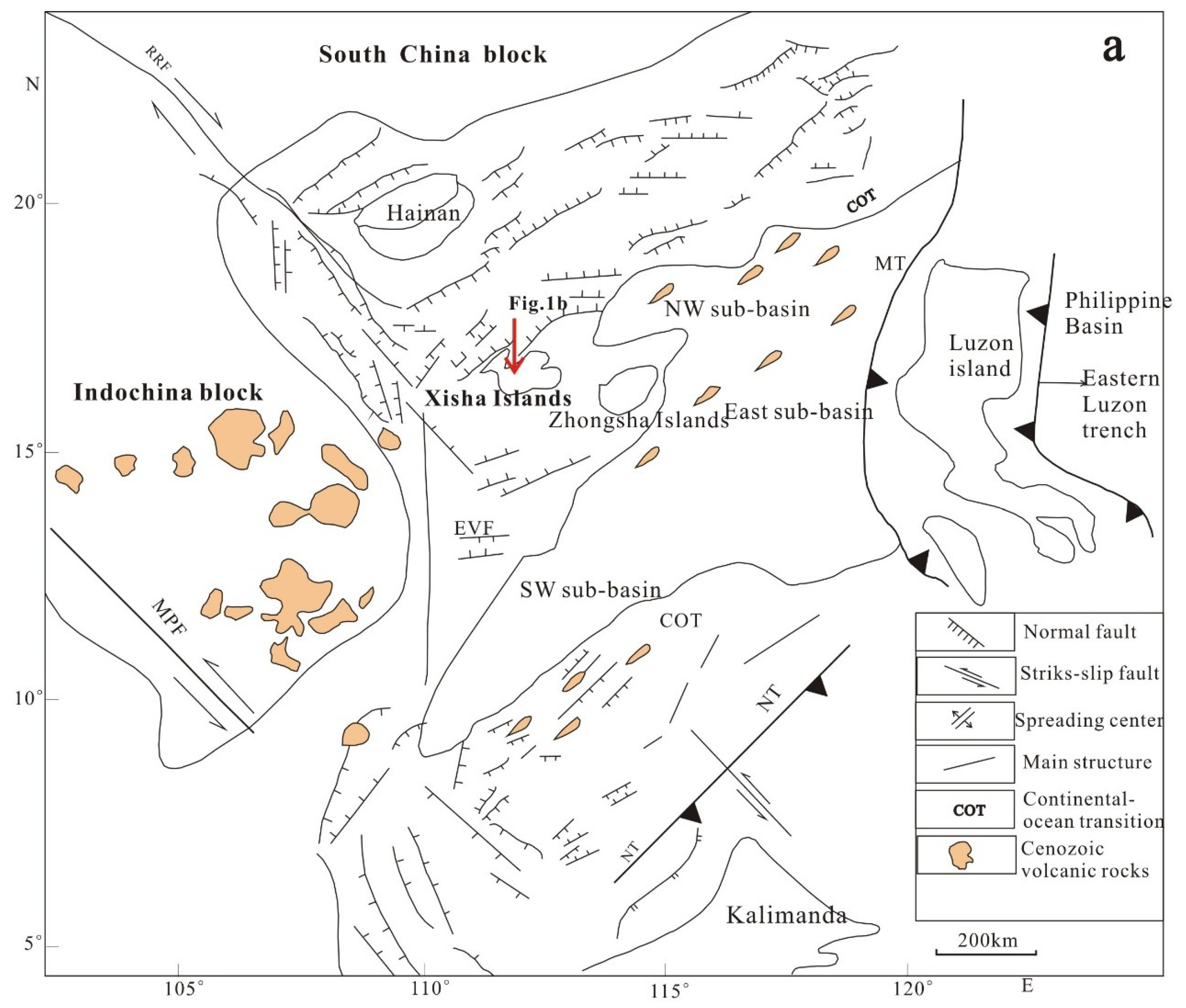
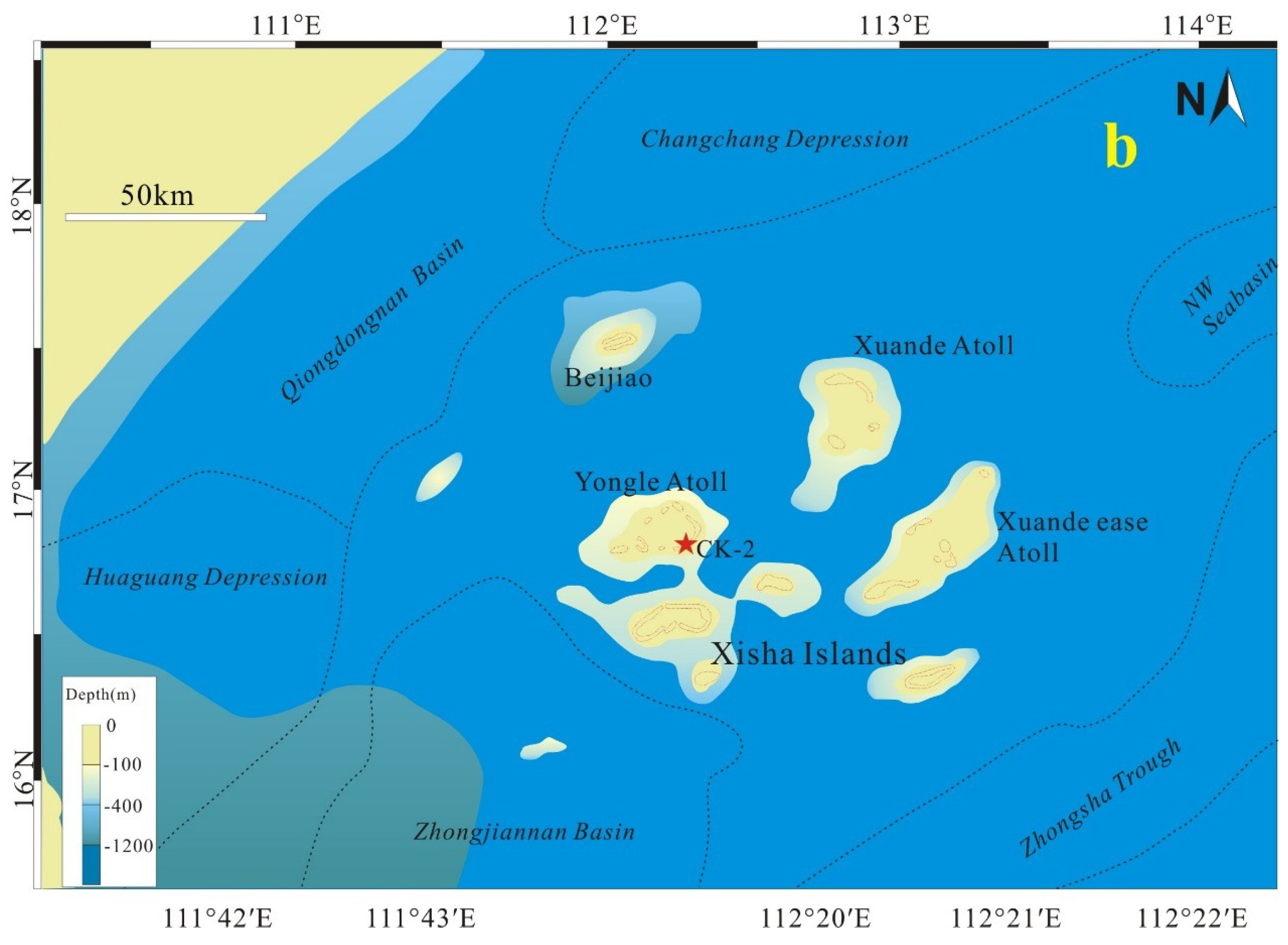

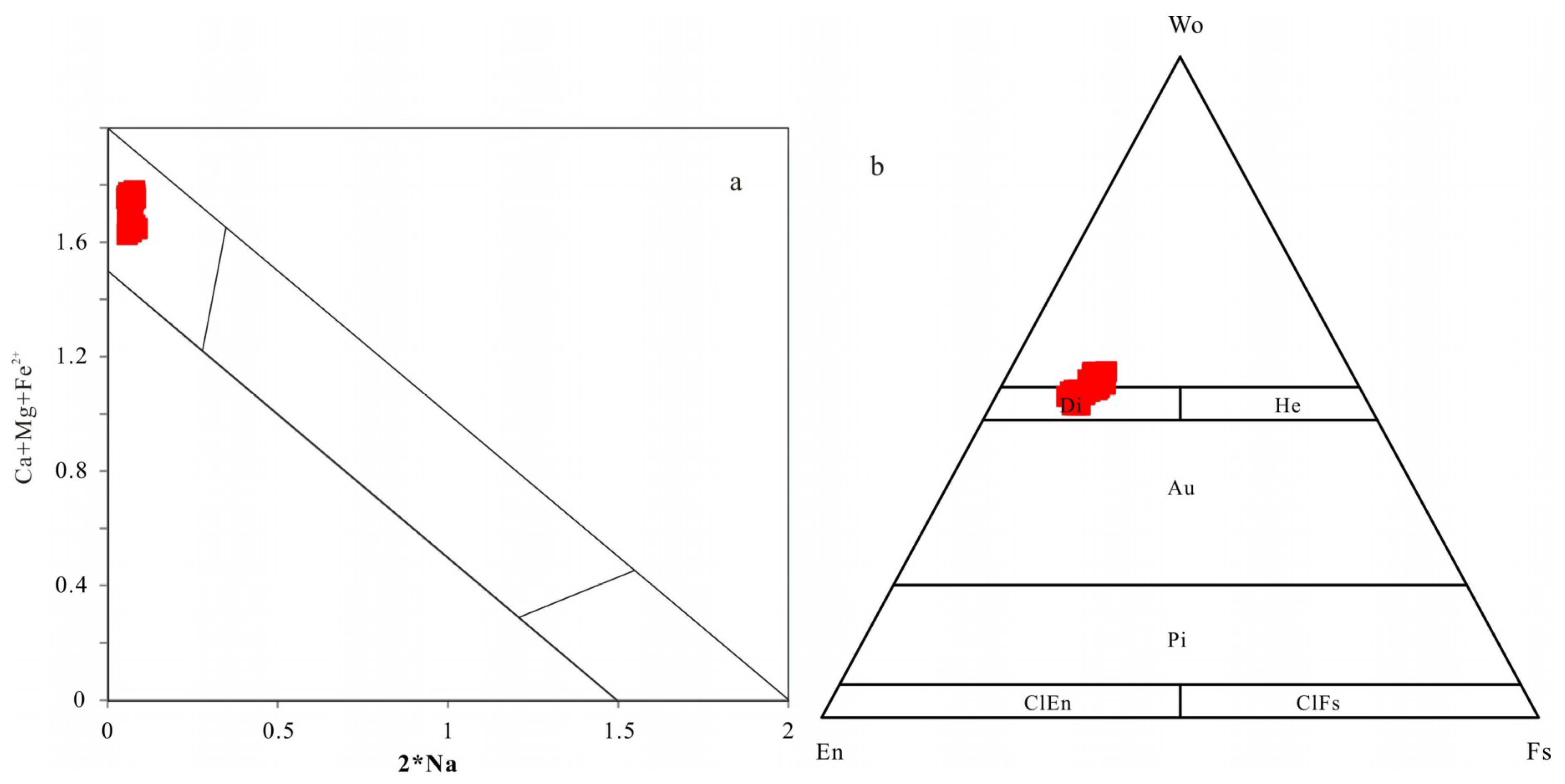
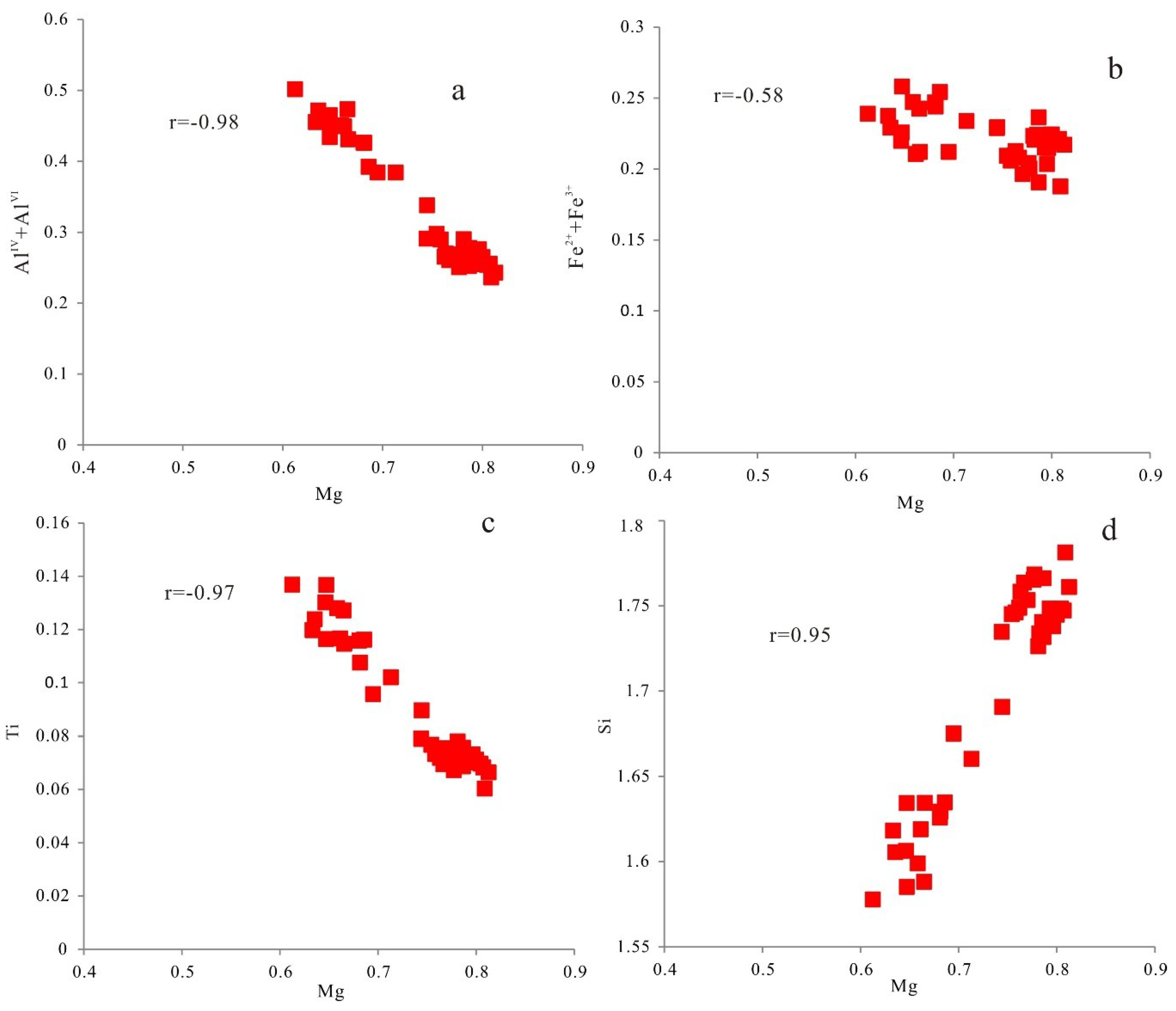
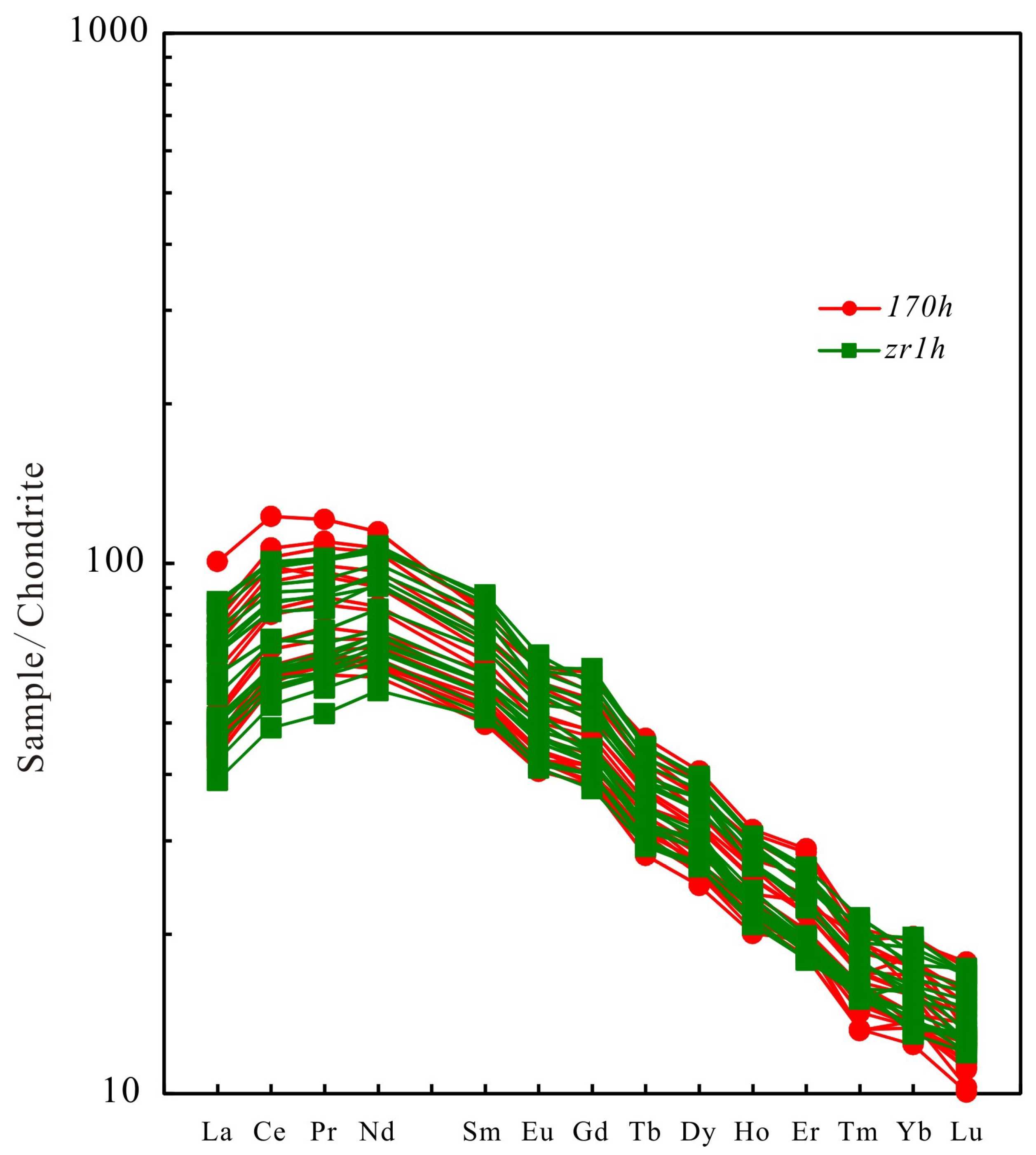
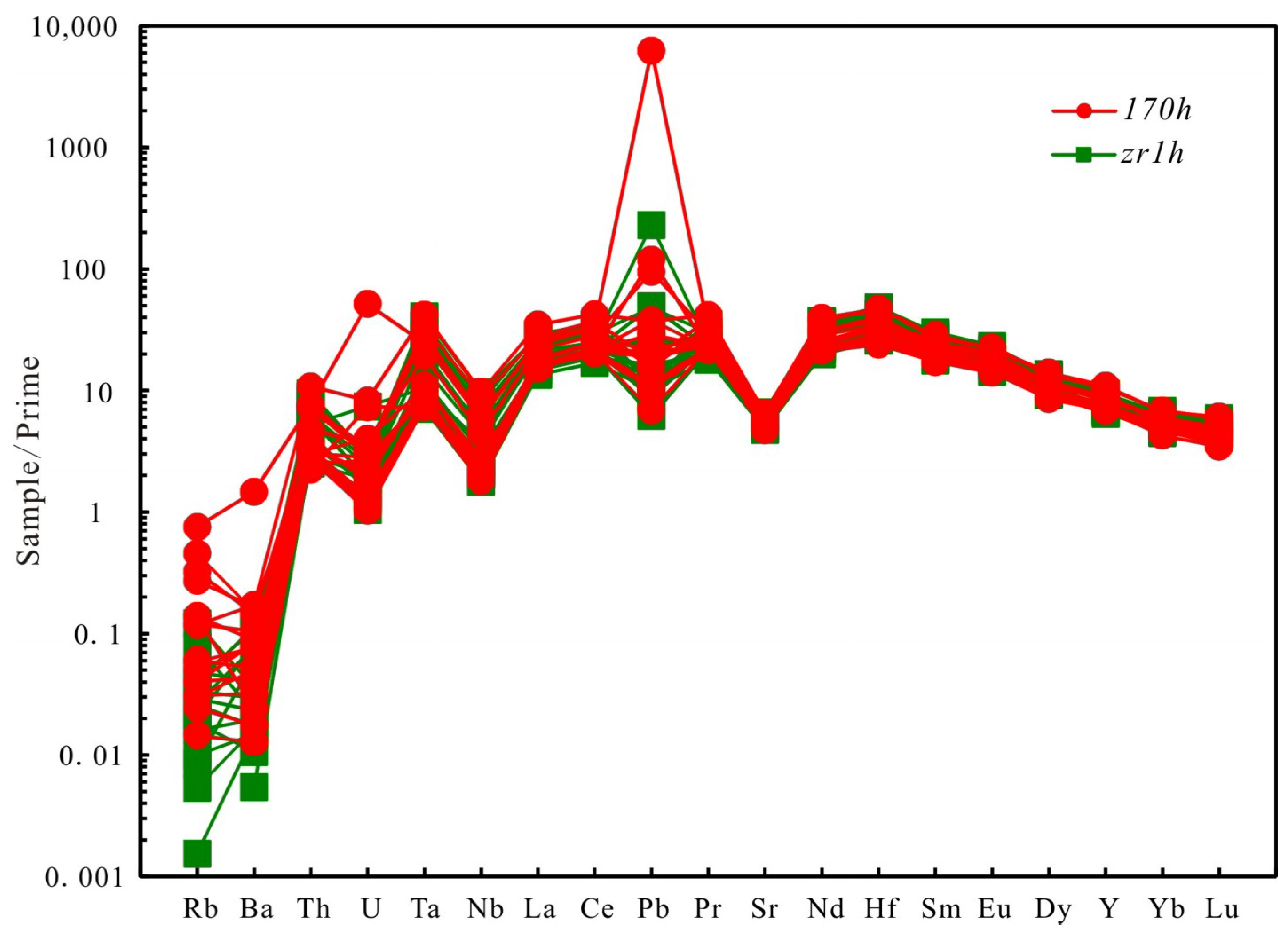
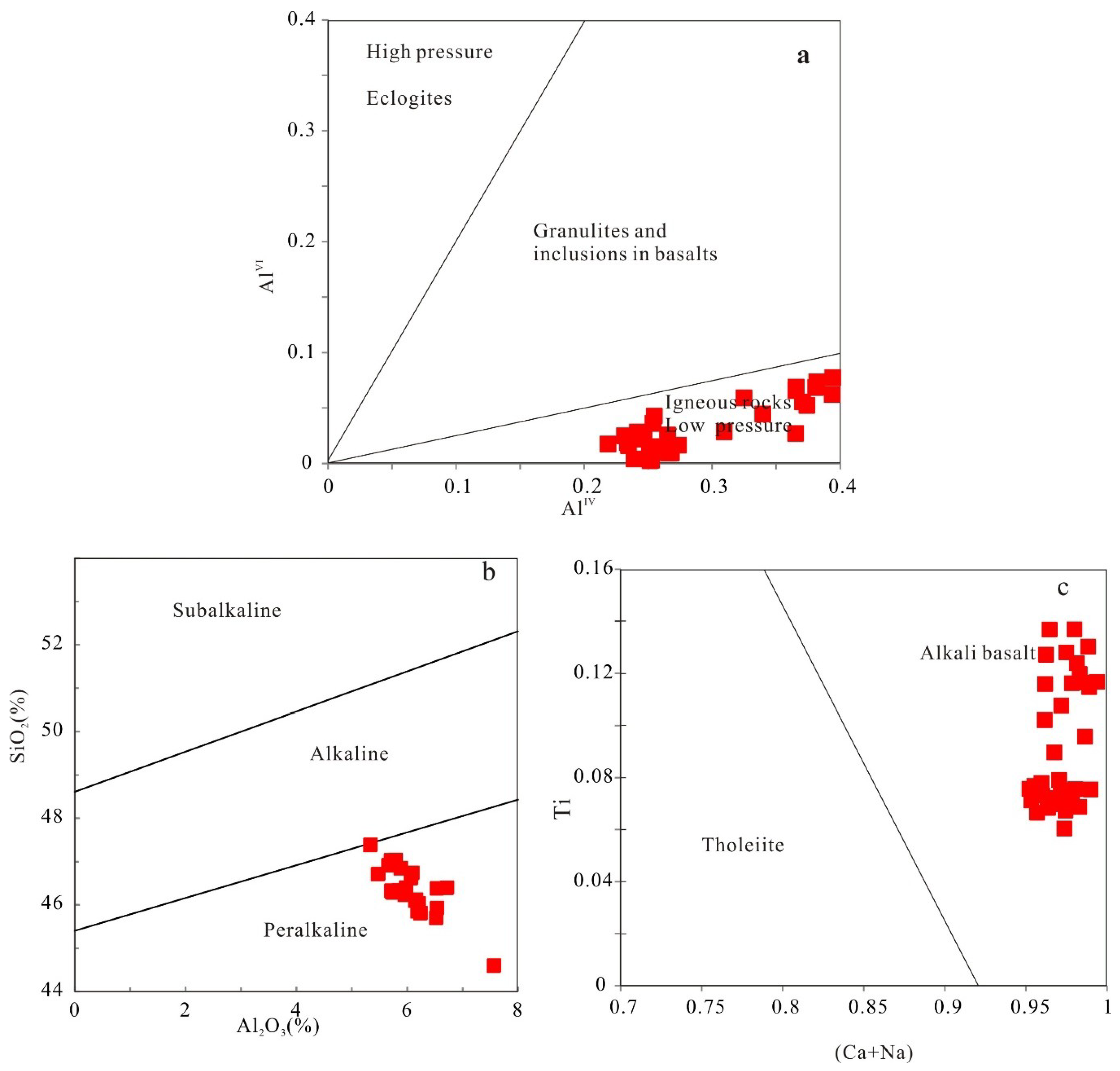
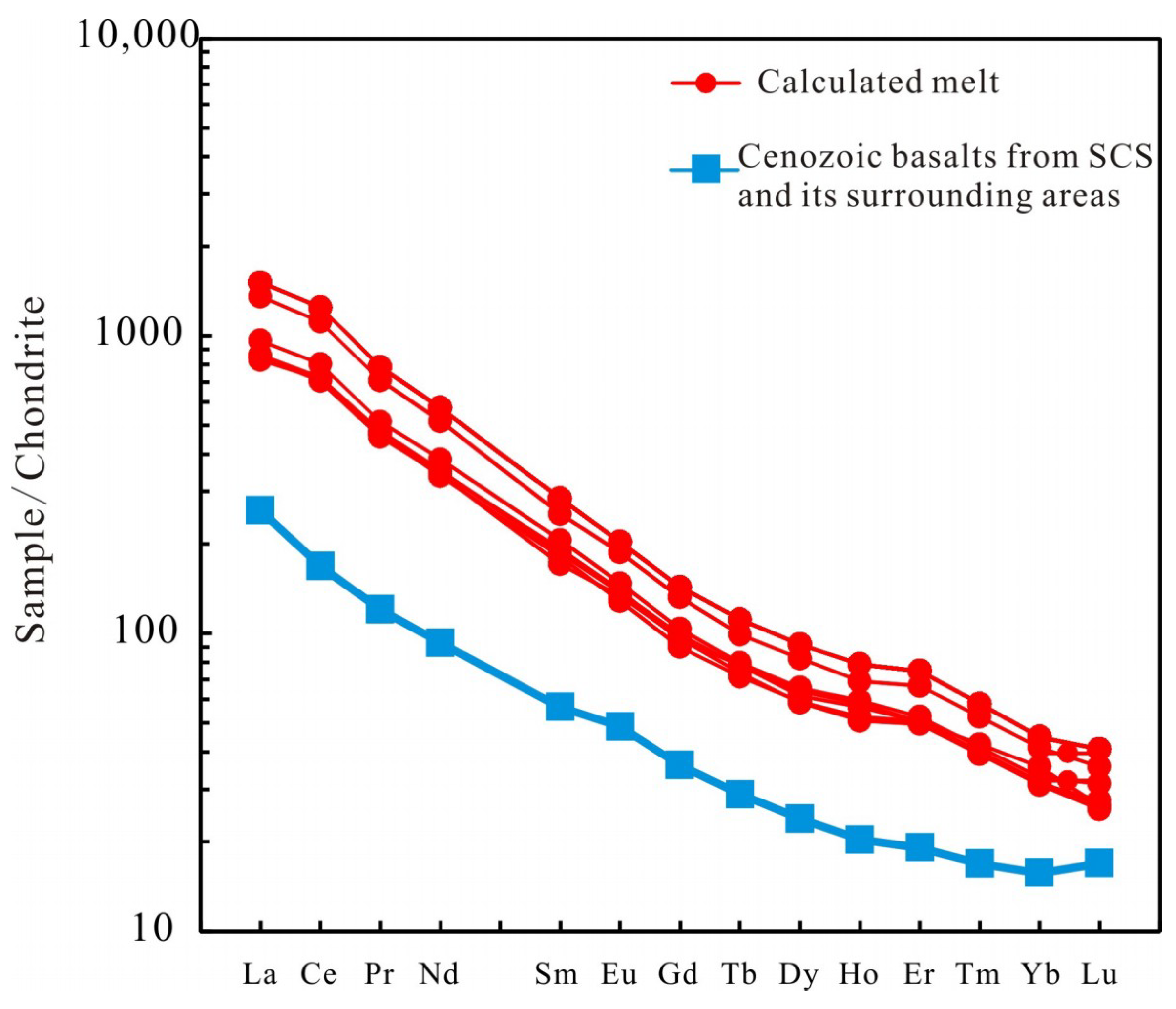
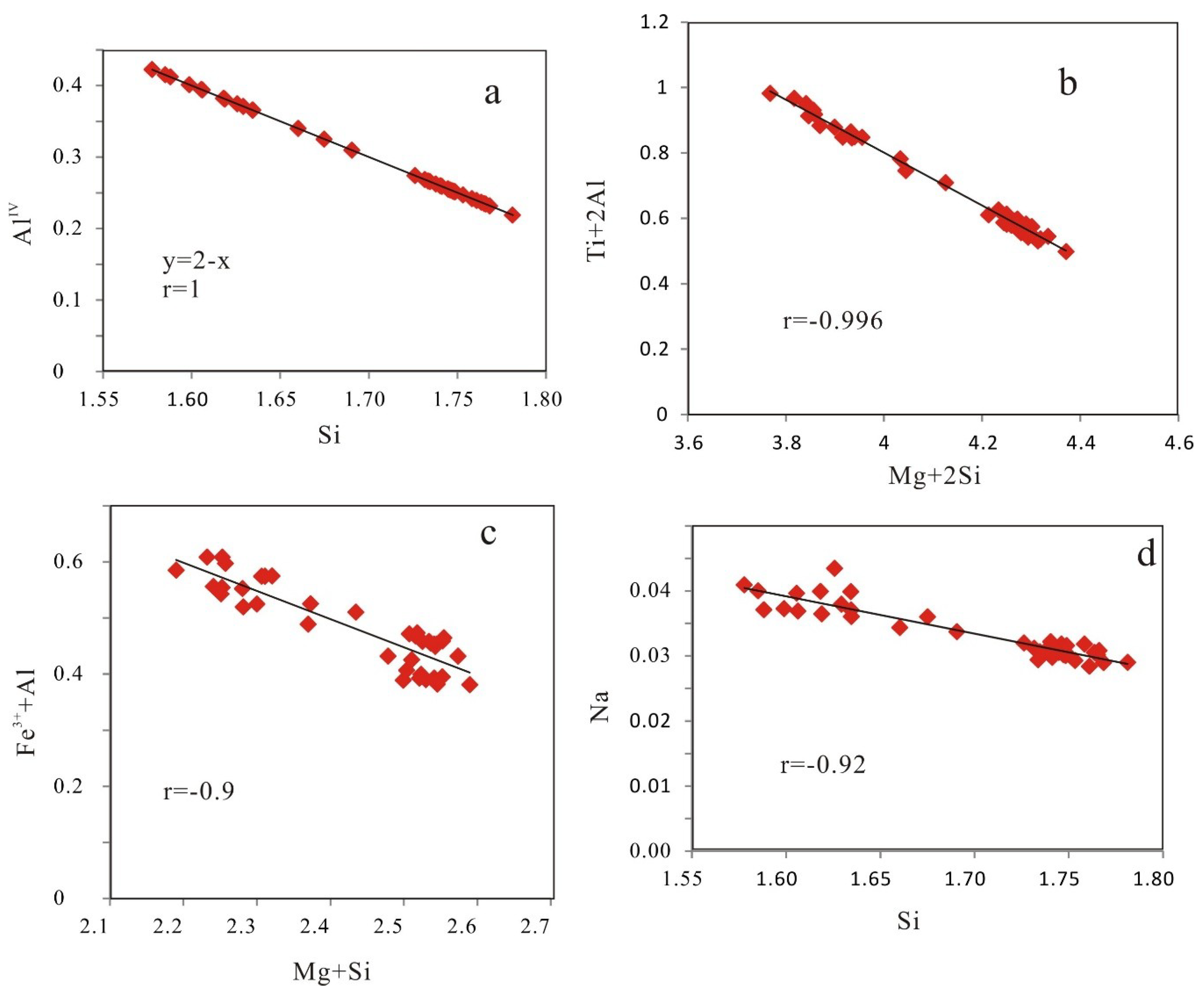
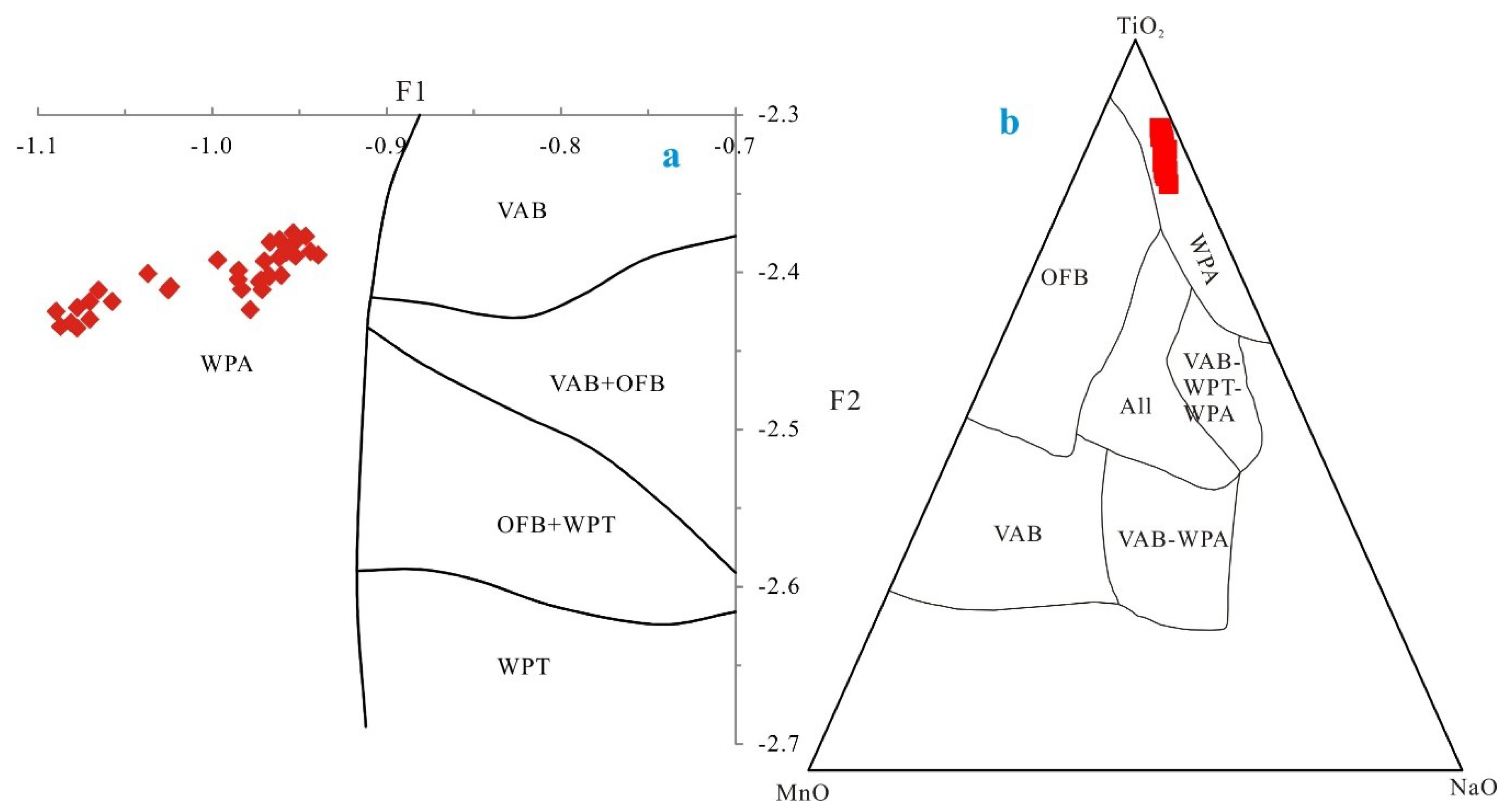
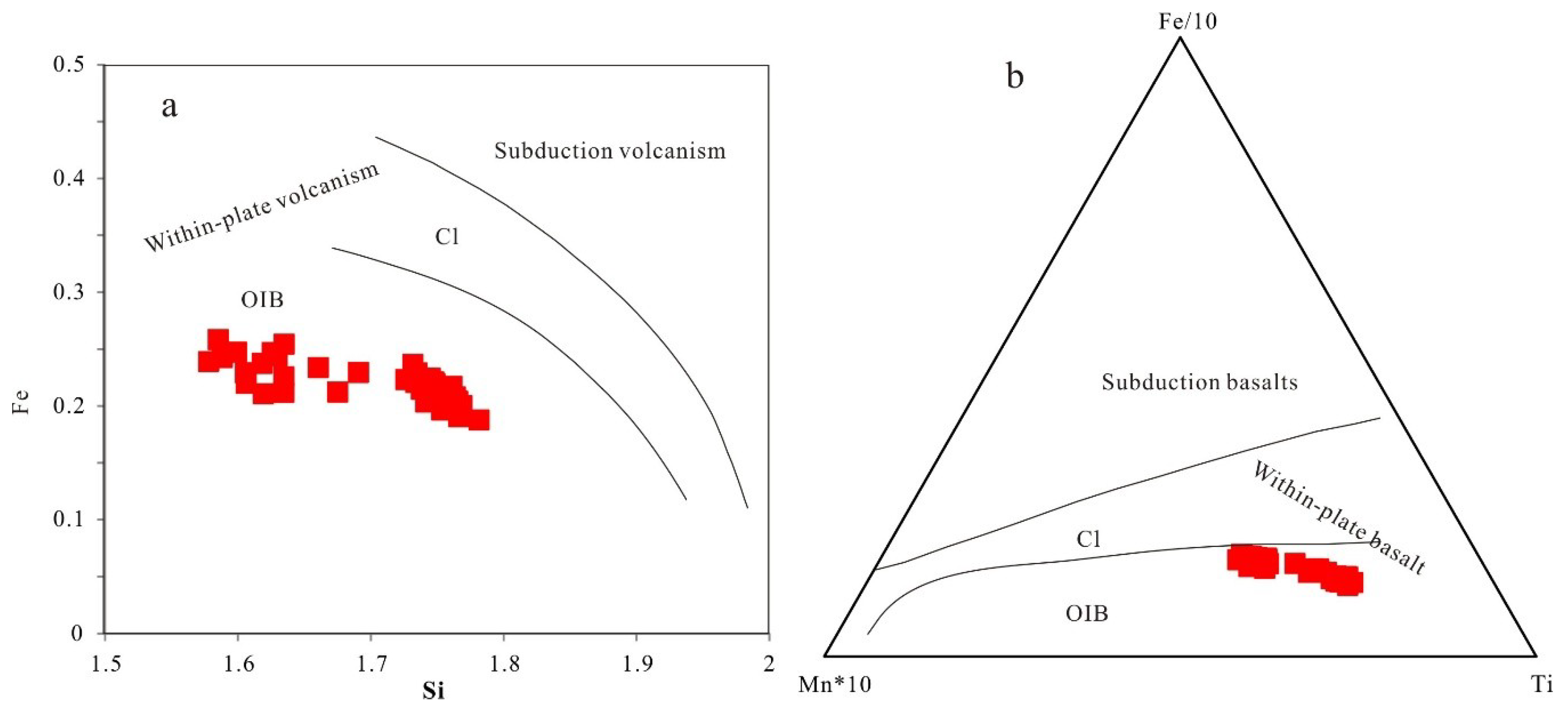
© 2018 by the authors. Licensee MDPI, Basel, Switzerland. This article is an open access article distributed under the terms and conditions of the Creative Commons Attribution (CC BY) license (http://creativecommons.org/licenses/by/4.0/).
Share and Cite
Zhang, Y.; Yu, K.; Qian, H. LA-ICP-MS Analysis of Clinopyroxenes in Basaltic Pyroclastic Rocks from the Xisha Islands, Northwestern South China Sea. Minerals 2018, 8, 575. https://doi.org/10.3390/min8120575
Zhang Y, Yu K, Qian H. LA-ICP-MS Analysis of Clinopyroxenes in Basaltic Pyroclastic Rocks from the Xisha Islands, Northwestern South China Sea. Minerals. 2018; 8(12):575. https://doi.org/10.3390/min8120575
Chicago/Turabian StyleZhang, Yu, Kefu Yu, and Handong Qian. 2018. "LA-ICP-MS Analysis of Clinopyroxenes in Basaltic Pyroclastic Rocks from the Xisha Islands, Northwestern South China Sea" Minerals 8, no. 12: 575. https://doi.org/10.3390/min8120575
APA StyleZhang, Y., Yu, K., & Qian, H. (2018). LA-ICP-MS Analysis of Clinopyroxenes in Basaltic Pyroclastic Rocks from the Xisha Islands, Northwestern South China Sea. Minerals, 8(12), 575. https://doi.org/10.3390/min8120575




